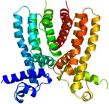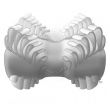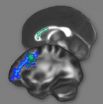(Press-News.org) AMES, Iowa – Edward Yu took note of the facts – nearly 2 million deaths each year, 9 million infected each year, developments of multidrug-resistant, extensively drug-resistant and now totally drug-resistant strains – and decided to shift his research focus to tuberculosis.
Yu, an Iowa State University and Ames Laboratory researcher, has described in the journal Nature the three-part structure that allows E. coli bacteria to pump out toxins and resist antibiotics.
And now, in a paper published online by the journal Nucleic Acids Research, a research team led by Yu describes the structure of a regulator that controls the expression of the multidrug efflux pump in Mycobacterium tuberculosis.
Yu – a professor of physics and astronomy, of chemistry, of biochemistry, biophysics and molecular biology in Iowa State's College of Liberal Arts and Sciences and an associate of the U.S. Department of Energy's Ames Laboratory – said the latest study is a starting point for a better understanding of how the tuberculosis bacterium is able to resist drugs.
The development of strains totally resistant to drugs "inspired us to move in this direction and try to understand the mechanism in developing drug resistance," Yu said.
"It is obvious that the emergence of these drug-resistant TB strains has evolved into a major threat and challenges our global prospects for TB control," Yu's research team wrote in its latest paper. "Thus, knowledge of the molecular mechanisms underlying drug resistance in M. tuberculosis is essential for the development of new strategies to combat this disease."
Yu's research is currently supported by the National Institutes of Health. The researchers' use of the Advanced Photon Source at Argonne National Laboratory in Argonne, Ill., was supported by the U.S. Department of Energy's Office of Basic Energy Sciences.
In addition to Yu, the research team includes Qijing Zhang, Iowa State's Frank Ramsey Endowed Professor of Veterinary Microbiology and Preventive Medicine and the College of Veterinary Medicine's officer of graduate education; Kanagalaghatta Rajashankar, a senior research associate in chemistry and chemical biology at Cornell University in Ithaca, N.Y., and associate director of the Northeastern Collaborative Access Team facility at the Advanced Photon Source; Iowa State post-doctoral research associates and Ames Lab associates Feng Long and Chih-Chia Su; Iowa State post-doctoral research associate Lei Dai; Iowa State graduate students and Ames Lab student associates Jani Reddy Bolla, Sylvia Do and Hsiang-Ting Lei; recent Iowa State graduate Xiao Chen; and Ames Lab undergraduate summer interns Jillian Gerkey and Daniel Murphy.
Prior to Yu's study, not much was known about the structure and function of the tuberculosis efflux pump regulator known as Rv3066.
That, in part, is because researchers have attributed drug resistance in tuberculosis to the bacterium's very thick cell wall. That wall makes it very difficult to get drugs into the bacterium.
The researchers used X-ray crystallography (including X-ray beams produced by the Advanced Photon Source) to study the Rv3066 structure. They collected data showing the regulator when the toxic compound ethidium bromide was present and when it was not.
The data revealed an asymmetric, two-part molecule with a spiral structure. The structure is flexible, allowing the regulator to recognize and respond to multiple drugs. In the presence of ethidium, Yu's group says the regulator responds with a rotational motion, inducing expression of the efflux pump that rids the bacterium of antimicrobial drugs.
Studying that structure and mechanism could make a difference in the fight against drug-resistant tuberculosis: "Elucidating the regulatory systems of multidrug efflux pumps in M. tuberculosis," Yu and the researchers wrote in their paper, "should allow us to understand how this bacterium contributes to multidrug resistance and how it adapts to environmental changes."
INFORMATION:
Contacts:
Edward Yu, Physics and Astronomy; Chemistry; Biochemistry, Biophysics and Molecular Biology; Ames Laboratory; 515-294-4955, ewyu@iastate.edu
Mike Krapfl, News Service, 515-294-4917, mkrapfl@iastate.edu
Iowa State, Ames Lab researchers study the structure of drug resistance in tuberculosis
2012-08-22
ELSE PRESS RELEASES FROM THIS DATE:
30 minutes of daily exercise does the trick
2012-08-22
Researchers at the University of Copenhagen have shown that 30 minutes of daily training provide an equally effective loss of weight and body mass as 60 minutes. Their results have just been published in the American Journal of Physiology.
Forty percent of Danish men are moderately overweight. For thirteen weeks, a research team at the Faculty of Medical and Health Sciences followed 60 heavy – but healthy – Danish men in their efforts to get into better shape. Half of the men were set to exercise for an hour a day, wearing a heart-rate monitor and calorie counter, while ...
Income, 'screen time' affect soda, junk food consumption
2012-08-22
(Edmonton) Preschoolers from low-income neighbourhoods and kids who spend more than two hours a day in front of a TV or video-game console have at least one thing in common: a thirst for sugary soda and juice, according to research from the University of Alberta.
Researchers from the faculties of Physical Education and Recreation, School of Public Health and Medicine & Dentistry surveyed parents to assess the dietary habits of 1,800 preschoolers in the Edmonton region as part of a larger study on diet, physical activity and obesity.
Researchers found that 54.5 per cent ...
Likely voters say president's 'first 100 days in office' should include plans for research
2012-08-22
WASHINGTON—August 22, 2012— On the eve of the political conventions, nearly two-thirds of likely voters say the next president should announce initiatives promoting medical progress during his "first 100 days in office," according to a new national public opinion poll commissioned by Research!America. And nearly three-quarters of those polled say it's important for candidates for the presidency and Congress to have a science advisor. The findings reveal deep concerns among voters about the lack of attention candidates and elected officials have assigned to research.
"Research ...
Ames Laboratory scientists crack long-standing chemistry mystery
2012-08-22
A team of researchers at the U.S. Department of Energy's (DOE's) Ames Laboratory has answered a key question concerning the widely-used Fenton reaction – important in wastewater treatment to destroy hazardous organic chemicals and decontaminate bacterial pathogens and in industrial chemical production. The naturally occurring reaction was first discovered in 1894 by H.J.H. Fenton, a British chemist at Cambridge, and involves hydrogen peroxide (H2O2) and iron.
How the Fenton reaction actually happens has remained in contention. Scientists have long debated whether it ...
Ancient fossils reveal how the mollusc got its teeth
2012-08-22
TORONTO, ON – The radula sounds like something from a horror movie – a conveyor belt lined with hundreds of rows of interlocking teeth. In fact, radulas are found in the mouths of most molluscs, from the giant squid to the garden snail. Now, a "prototype" radula found in 500-million-year-old fossils studied by University of Toronto graduate student Martin Smith, shows that the earliest radula was not a flesh-rasping terror, but a tool for humbly scooping food from the muddy sea floor.
The Cambrian animals Odontogriphus and Wiwaxia might not have been much to look at ...
UCI microbiologists find new approach to fighting viral illnesses
2012-08-22
Irvine, Calif., Aug. 22, 2012 — By discovering how certain viruses use their host cells to replicate, UC Irvine microbiologists have identified a new approach to the development of universal treatments for viral illnesses such as meningitis, encephalitis, hepatitis and possibly the common cold.
The UCI researchers, working with Dutch colleagues, found that certain RNA viruses hijack a key DNA repair activity of human cells to produce the genetic material necessary for them to multiply.
For many years, scientists have known that viruses rely on functions provided by ...
Australian general practitioners in training spend less time with peds patients than with adults
2012-08-22
Ann Arbor, Mich. — Australian doctors-in-training spend significantly less time consulting with pediatric patients than they do with adults, according to a new study published in the journal Australian Family Physician.
The study found that the proportion of longer consultations – more than 20 minutes -- for children was significantly less than that for adults and seniors among general practice registrars, says Gary Freed, M.D., M.P.H., the lead author on the study and Australian-American health policy fellow, Australian Health Workforce Institute at the University of ...
Close contact with young people at risk of suicide has no effect
2012-08-22
Researchers, doctors and patients tend to agree that during the high-risk period after an attempted suicide, the treatment of choice is close contact, follow-up and personal interaction in order to prevent a tragic repeat. Now, however, new research shows that this strategy does not work. These surprising results from Mental Health Services in the Capital Region of Denmark and the University of Copenhagen have just been published in the British Medical Journal.
Researchers from Mental Health Services in the Capital Region of Denmark and the University of Copenhagen have ...
Rewired visual input to sound-processing part of the brain leads to compromised hearing
2012-08-22
ATLANTA – Scientists at Georgia State University have found that the ability to hear is lessened when, as a result of injury, a region of the brain responsible for processing sounds receives both visual and auditory inputs.
Yu-Ting Mao, a former graduate student under Sarah L. Pallas, professor of neuroscience, explored how the brain's ability to change, or neuroplasticity, affected the brain's ability to process sounds when both visual and auditory information is sent to the auditory thalamus.
The study was published in the Journal of Neuroscience.
The auditory thalamus ...
Intense prep for law school admission test alters brain structure
2012-08-22
Intensive preparation for the Law School Admission Test (LSAT) actually changes the microscopic structure of the brain, physically bolstering the connections between areas of the brain important for reasoning, according to neuroscientists at the University of California, Berkeley.
The results suggest that training people in reasoning skills – the main focus of LSAT prep courses – can reinforce the brain's circuits involved in thinking and reasoning and could even up people's IQ scores.
"The fact that performance on the LSAT can be improved with practice is not new. ...



